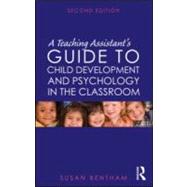
Note: Supplemental materials are not guaranteed with Rental or Used book purchases.
Purchase Benefits
Looking to rent a book? Rent A Teaching Assistant's Guide to Child Development and Psychology in the Classroom: Second edition [ISBN: 9780415569231] for the semester, quarter, and short term or search our site for other textbooks by Bentham; Susan. Renting a textbook can save you up to 90% from the cost of buying.
| List of illustrations | p. x |
| Acknowledgements | p. xiii |
| Introduction | p. 1 |
| Definitions of reflection and the reflective practitioner | p. 2 |
| Ways to reflect: the reflective account | p. 4 |
| Ways to reflect: the professional dialogue | p. 7 |
| Final comments | p. 9 |
| Basic principles underlying pupil development and learning | p. 11 |
| Intellectual and cognitive skills | p. 11 |
| Language and communication skills | p. 27 |
| Social and emotional skills | p. 34 |
| Specific skills and abilities | p. 49 |
| Summary | p. 62 |
| Learning support strategies | p. 64 |
| Learning strategies as a way to promote effective learning | p. 64 |
| Specific skills | p. 75 |
| Emotional responses | p. 83 |
| Reflection | p. 86 |
| Learning styles | p. 89 |
| Barriers to effective learning | p. 89 |
| Learning styles | p. 89 |
| Adapting learning support Strategies to accommodate different types of learning style | p. 94 |
| Learning styles, personalized learning and assessment for learning | p. 96 |
| Pupils with additional needs | p. 100 |
| Inclusion | p. 100 |
| Terminology | p. 100 |
| Assessing additional needs | p. 102 |
| Autism Spectrum Conditions and Asperger's syndrome | p. 105 |
| Dyslexia | p. 110 |
| Dyspraxia | p. 115 |
| Down's syndrome | p. 118 |
| ADHD | p. 121 |
| Speech, language and communication difficulties | p. 126 |
| Sensory impairment | p. 130 |
| Physical impairment | p. 134 |
| Bilingual and multilingual pupils | p. 136 |
| Looked after children | p. 139 |
| Gifted and talented pupils | p. 141 |
| Pupils with poor working memory | p. 144 |
| Putting it all together | p. 145 |
| Managing behaviour for learning | p. 147 |
| Introduction | p. 147 |
| Aspects of culture, upbringing, home circumstances and physical and emotional health that could influence the pupil's interactions with others | p. 150 |
| Intervention strategies | p. 153 |
| Developing thinking skills: giving choices and stating consequences | p. 158 |
| Being proactive: monitoring the group to spot signs of conflict at an early stage | p. 160 |
| Establishing effective working relationships with pupils and colleagues | p. 163 |
| Basic principles of effective communication with pupils | p. 163 |
| Techniques of active listening | p. 164 |
| Four levels of listening | p. 168 |
| Interpreting non-verbal communication | p. 168 |
| Basic principles of working with groups | p. 170 |
| Basic principles of effective working relationships with colleagues | p. 175 |
| Self-esteem, motivation and independent learners | p. 179 |
| Definitions of self-esteem and self-concept | p. 179 |
| Factors that affect the development of self-esteem and self-concept | p. 180 |
| Strategies that will enhance self-esteem | p. 181 |
| The relationship between self-esteem and achievement | p. 184 |
| Motivation | p. 185 |
| Factors that promote independence | p. 189 |
| Strategies designed to encourage independence | p. 190 |
| Glossary | p. 193 |
| Bibliography | p. 202 |
| Index | p. 211 |
| Table of Contents provided by Ingram. All Rights Reserved. |
The New copy of this book will include any supplemental materials advertised. Please check the title of the book to determine if it should include any access cards, study guides, lab manuals, CDs, etc.
The Used, Rental and eBook copies of this book are not guaranteed to include any supplemental materials. Typically, only the book itself is included. This is true even if the title states it includes any access cards, study guides, lab manuals, CDs, etc.